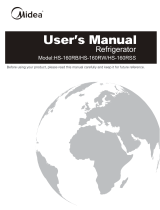
Technical safety
~
Before setting up the appliance,
check it for any externally visible
damage.
Do not install and use a damaged
appliance.
~
This appliance contains the coolant
Isobutane (R600a), a natural gas which
is environmentally friendly. Although it
is flammable, it does not damage the
ozone layer and does not increase the
greenhouse effect. The use of this
environmentally friendly coolant has,
however, led to a slight increase in the
noise level of the appliance. In addition
to the noise of the compressor, you
might be able to hear the coolant
flowing around the system. This is
unavoidable, but does not have any
adverse effect on the performance of
the appliance.
Care must be taken during the
transportation and setting up of the
appliance that no parts of the cooling
system are damaged. Leaking coolant
can damage the eyes.
In the event of any damage:
- avoid open fires and anything which
creates a spark,
- disconnect from the mains,
- air the room in which the appliance is
located for several minutes and
- contact the Service Department for
advice.
~
The more coolant there is in an
appliance, the larger the room it should
be installed in. In the event of a
leakage, if the appliance is in a small
room, there is the danger of
combustible gases building up.
For every8gofcoolant at least 1 m
3
of
room space is required. The amount of
coolant in the appliance is stated on the
data plate inside the appliance.
~
Before connecting the appliance to
the mains supply, make sure that the
voltage and frequency correspond to
the rating on the data plate.
This data must correspond in order to
avoid the risk of damage to the
appliance. Consult a qualified
electrician if in any doubt.
~
The electrical safety of this
appliance can only be guaranteed
when continuity is complete between it
and an effective earthing system which
complies with current local and national
safety regulations. It is most important
that this basic safety requirement is
present and tested regularly, and
where there is any doubt, the
household wiring system should be
inspected by a qualified electrician.
The manufacturer cannot be held liable
for damage or injury caused by the lack
of or inadequacy of an effective
earthing system (e.g. electric shock).
~
If the connection cable is faulty it
must only be replaced by a Miele
approved service technician to protect
the user from danger.
Warning and Safety instructions
9






















